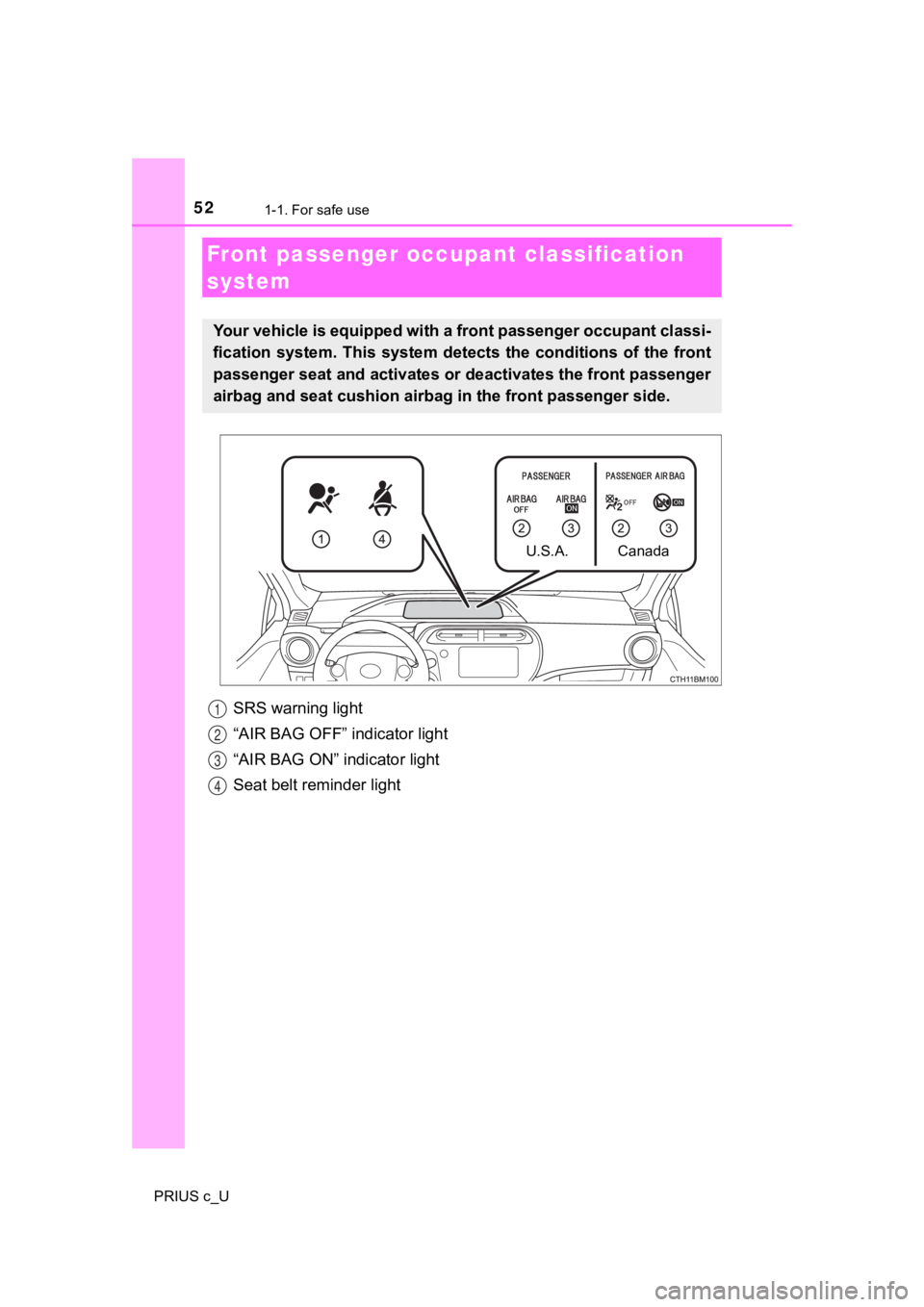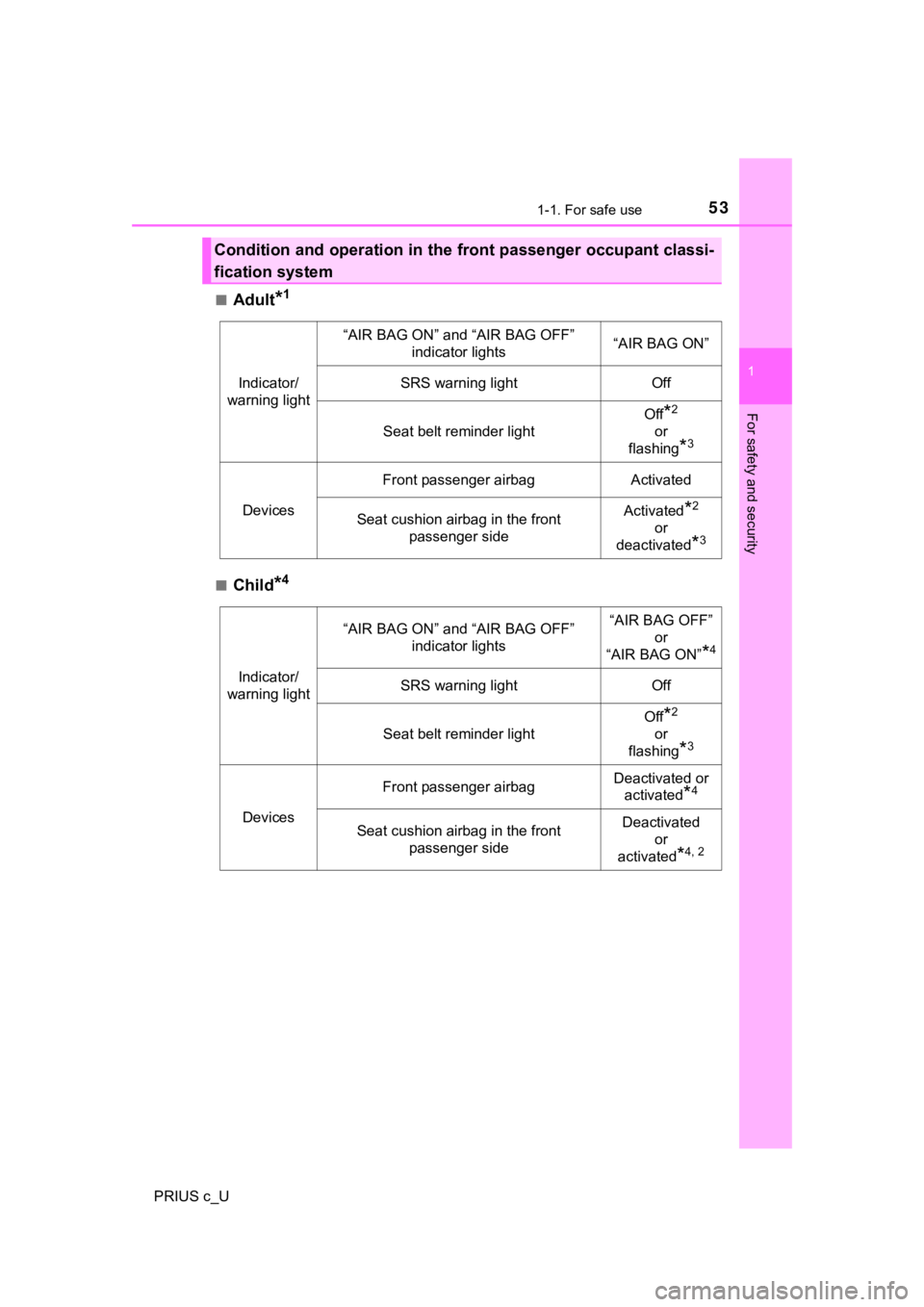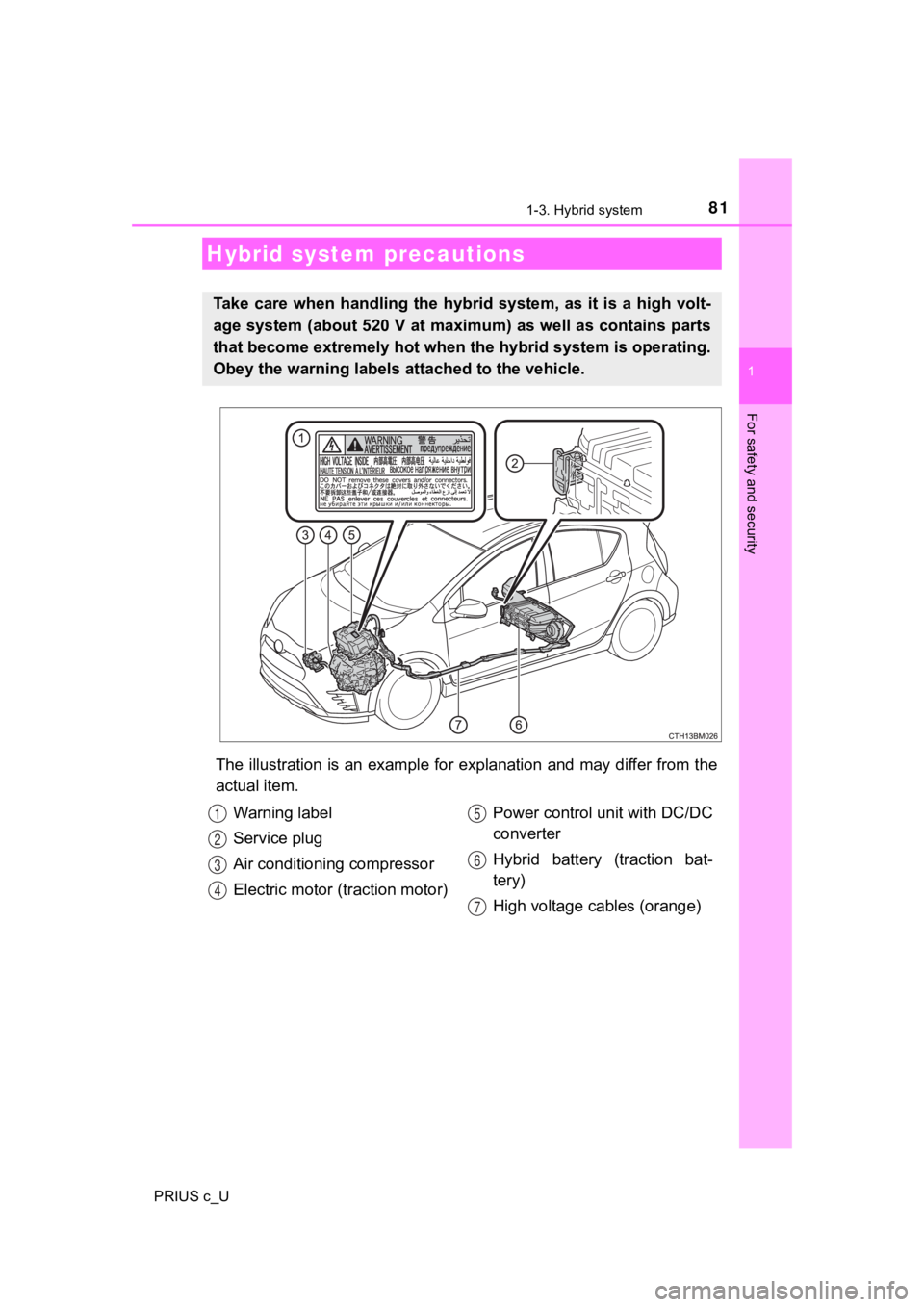air condition TOYOTA PRIUS C 2020 Owners Manual
[x] Cancel search | Manufacturer: TOYOTA, Model Year: 2020, Model line: PRIUS C, Model: TOYOTA PRIUS C 2020Pages: 600, PDF Size: 12.02 MB
Page 5 of 600

5
1
9 8 6 5
4
3
2
PRIUS c_U
10
7
5-9. Bluetooth® Audio
(Multimedia system)
Listening to Bluetooth
®
Audio ............................... 330
5-10. Bluetooth
® phone
(Multimedia system)
Using a Bluetooth
®
Phone.............................. 332
Making a call ..................... 335
Receiving a call ................. 338
Speaking on the phone ..... 339
Bluetooth
® phone
message function ............ 343
Using the steering wheel switches ................ 348
Bluetooth
® phone
settings............................ 349
Contact/Call History Settings ........................... 351
What to do if... (Troubleshooting) ............ 361
5-11. Bluetooth
®
(Multimedia system)
Bluetooth
®......................... 365
5-12. Using the voice command system
(Multimedia system)
Voice command system .... 370 6-1. Using the air
conditioning system
and defogger
Automatic air conditioning system ......... 376
Seat heaters ...................... 384
6-2. Using the interior lights Interior lights list................. 385
• Interior lights.................. 386
• Personal lights............... 386
6-3. Using the storage features
List of storage features ...... 388
• Glove box ...................... 389
• Console box .................. 389
• Auxiliary boxes .............. 390
• Cup holders ................... 391
• Bottle holders ................ 392
6-4. Other interior features Other interior features........ 393
• Sun visors ..................... 393
• Vanity mirrors ................ 393
• Power outlet .................. 394
• Coat hooks .................... 395
• Assist grips .................... 396
• Luggage cover .............. 397
6Interior features
Page 6 of 600

TABLE OF CONTENTS6
PRIUS c_U7-1. Maintenance and care
Cleaning and protecting the vehicle exterior .......... 400
Cleaning and protecting the vehicle interior ........... 403
7-2. Maintenance Maintenance requirements ................... 409
General maintenance ........ 412
Emission inspection and maintenance (I/M)
programs ......................... 415
7-3. Do-it-yourself maintenance
Do-it-yourself service precautions ..................... 416
Hood.................................. 419
Positioning a floor jack ...... 421
Engine compartment ......... 422
12-volt battery ................... 431
Tires .................................. 435
Tire inflation pressure........ 444
Wheels .............................. 447
Air conditioning filter .......... 449
Wireless remote control/ electronic key battery ...... 451
Checking and replacing fuses ................ 454
Light bulbs ......................... 458 8-1. Essential information
Emergency flashers ........... 468
If your vehicle has to be stopped in
an emergency.................. 469
If the vehicle is trapped in rising water .................. 471
8-2. Steps to take in an emergency
If your vehicle needs to be towed ...................... 472
If you think something is wrong ........................... 479
If a warning light turns on or a warning buzzer
sounds ............................. 480
If a warning message is displayed...................... 488
If you have a flat tire .......... 505
If the hybrid system will not start ..................... 518
If the electronic key does not operate properly .......... 520
If the vehicle 12-volt
battery is discharged ....... 522
If your vehicle overheats.... 529
If the vehicle becomes stuck ................ 533
7Maintenance and care8When trouble arises
Page 19 of 600

19Pictorial index
PRIUS c_UTurn signal lever . . . . . . . . . . . . . . . . . . . . . . . . . . . . . . . . . . P. 206
Headlight switch . . . . . . . . . . . . . . . . . . . . . . . . . . . . . . . . . . P. 208
Headlights/parking lights/tail lights/daytime running lights . .
. . P. 208
Front fog lights
*1 . . . . . . . . . . . . . . . . . . . . . . . . . . . . . . . . . . . P. 212
Windshield wiper and washer switch . . . . . . . . . . . . . . . . . P. 214
Usage . . . . . . . . . . . . . . . . . . . . . . . . . . . . . . . . . . . . . . . . . . . P. 214
Adding washer fluid . . . . . . . . . . . . . . . . . . . . . . . . . . . . . . . . . P. 430
Emergency flasher switch . . . . . . . . . . . . . . . . . . . . . . . . . . P. 468
Fuel filler door opener . . . . . . . . . . . . . . . . . . . . . . . . . . . . . . P. 221
Hood lock release lever. . . . . . . . . . . . . . . . . . . . . . . . . . . . . P. 419
Tilt and telescopic steering lock release lever . . . . . . . . . . P. 158
Air conditioning system . . . . . . . . . . . . . . . . . . . . . . . . . . . . P. 376
Usage . . . . . . . . . . . . . . . . . . . . . . . . . . . . . . . . . . . . . . . . . . . P. 376
Rear window defogger . . . . . . . . . . . . . . . . . . . . . . . . . . . . . . . P. 378
Multimedia system
*1. . . . . . . . . . . . . . . . . . . . . . . . . . . . . . . P. 281
Navigation system
*1, 2
Power outlet . . . . . . . . . . . . . . . . . . . . . . . . . . . . . . . . . . . . . . P. 394
*1: If equipped
*2: Refer to “NAVIGATION SYSTEM OWNER’S MANUAL”.
4
5
6
7
8
9
10
11
12
Page 47 of 600

471-1. For safe use
1
For safety and security
PRIUS c_U
■If the SRS airbags deploy (inflate)
●Slight abrasions, burns, bruising etc., may be sustained from S RS airbags,
due to the extremely high speed deployment (inflation) by hot g ases.
● A loud noise and white powder will be emitted.
● Parts of the airbag module (steering wheel hub, airbag cover an d inflator) as
well as the front seats, parts of the front and rear pillars, and roof side rails,
may be hot for several minutes. The airbag itself may also be h ot.
● The windshield may crack.
■ SRS airbag deployment condi tions (SRS front airbags)
● The SRS front airbags will deploy in the event of an impact tha t exceeds the
set threshold level (the level of force corresponding to an approximately 12 -
18 mph [20 - 30 km/h] frontal collision with a fixed wall that does not move or
deform).
However, this threshold velocity will be considerably higher in the following
situations:
• If the vehicle strikes an object, such as a parked vehicle or sign pole,
which can move or deform on impact
• If the vehicle is involved in an underride collision, such as a collision in
which the front of the vehicle “underrides”, or goes under, the bed of a
truck
● Depending on the type of collision, it is possible that only th e seat belt pre-
tensioners will activate.
● The SRS front airbags for the front passenger will not activate if there is no
passenger sitting in the front passenger seat. However, the SRS front air-
bags for the front passenger may deploy if luggage is put in the seat, even if
the seat is unoccupied.
● The SRS seat cushion airbag on the front passenger seat will not operate if
the occupant is not wearing a seat belt.
■ SRS airbag deployment conditions (SRS side and curtain shield a irbags)
● The SRS side and curtain shield airbags will deploy in the even t of an
impact that exceeds the set threshold level (the level of force corresponding
to the impact force produced by an approximately 3300 lb. [1500 kg] vehicle
colliding with the vehicle cabin from a direction perpendicular to the vehicle
orientation at an approximate speed of 12 - 18 mph [20 - 30 km/ h]).
● Both SRS curtain shield airbags will deploy in the event of veh icle rollover.
● Both SRS curtain shield airbags will deploy in the event of a s evere frontal
collision.
Page 48 of 600

481-1. For safe use
PRIUS c_U■
Conditions under which the SRS ai rbags may deploy (inflate), other than
a collision
The SRS front airbags and SRS curtain shield airbags may also d eploy if a
serious impact occurs to the underside of your vehicle. Some ex amples are
shown in the illustration.
The SRS curtain shield airbags may also deploy under the situat ions shown
in the illustration.
■ Types of collisions that may not deploy the SRS airbags (SRS fr ont air-
bags)
The SRS front airbags do not generally inflate if the vehicle i s involved in a
side or rear collision, if it rolls over, or if it is involved in a low-speed frontal
collision. But, whenever a collision of any type causes suffici ent forward
deceleration of the vehicle, deployment of the SRS front airbag s may occur.
●
Hitting a curb, edge of pavement or
hard surface
● Falling into or jumping over a deep hole
● Landing hard or falling
● The angle of vehicle tip-up is marginal.
● The vehicle skids and hits a curb stone.
●Collision from the side
● Collision from the rear
● Vehicle rollover
Page 52 of 600

521-1. For safe use
PRIUS c_U
SRS warning light
“AIR BAG OFF” indicator light
“AIR BAG ON” indicator light
Seat belt reminder light
Front passenger occupant classification
system
Your vehicle is equipped with a front passenger occupant classi -
fication system. This system det ects the conditions of the front
passenger seat and activates or deactivates the front passenger
airbag and seat cushion airbag in the front passenger side.
U.S.A. Canada
1
2
3
4
Page 53 of 600

531-1. For safe use
1
For safety and security
PRIUS c_U■
Adult*1
■Child*4
Condition and operation in the front passenger occupant classi-
fication system
Indicator/
warning light
“AIR BAG ON” and “AIR BAG OFF” indicator lights“AIR BAG ON”
SRS warning lightOff
Seat belt reminder light
Off*2
or
flashing
*3
Devices
Front passenger airbagActivated
Seat cushion airbag in the front passenger sideActivated*2
or
deactivated
*3
Indicator/
warning light
“AIR BAG ON” and “AIR BAG OFF” indicator lights“AIR BAG OFF”
or
“AIR BAG ON”
*4
SRS warning lightOff
Seat belt reminder light
Off*2
or
flashing
*3
Devices
Front passenger airbagDeactivated or activated
*4
Seat cushion airbag in the front passenger sideDeactivated or
activated
*4, 2
Page 81 of 600

811-3. Hybrid system
1
For safety and security
PRIUS c_U
The illustration is an example for explanation and may differ from the
actual item.
Hybrid system precautions
Take care when handling the hybrid system, as it is a high volt -
age system (about 520 V at maximum) as well as contains parts
that become extremely hot when the hybrid system is operating.
Obey the warning labels attached to the vehicle.
Warning label
Service plug
Air conditioning compressor
Electric motor (traction motor) Power control unit with DC/DC
converter
Hybrid battery (traction bat-
tery)
High voltage cables (orange)1
2
3
4
5
6
7
Page 134 of 600

1343-2. Opening, closing and locking the doors
PRIUS c_U
■Switching the door unlock func tion (vehicles with a smart key system)
It is possible to set which doors the entry function unlocks using the wireless
remote control.
Turn the power switch off.
When the indicator light on the key surface is not on, press an d hold
or for about 5 seconds while pressing and holding .
The setting changes each time an operation is performed, as sho wn below.
(When changing the setting continuously, release the buttons, w ait for at least
5 seconds, and repeat step 2.)
■ Conditions affecting the operation of the smart key system or w ireless
remote control
Vehicles without a smart key system
The wireless remote control function may not operate normally i n the follow-
ing situations:
● When the wireless key battery is depleted
● Near a TV tower, electric power plant, gas station, radio stati on, large dis-
play, airport or other facility that generates strong radio wav es or electrical
noise
● When carrying a portable radio, cellular phone or other wireles s communi-
cation device
● When the wireless key is in contact with, or is covered by a me tallic object
● When other wireless keys (that emits radio waves) are being use d nearby
● If window tint with a metallic content or metallic objects are attached to the
rear window
Vehicles with a smart key system
P. 143
■ Customization that can be configured at Toyota dealer
Settings (e.g. unlocking function using a key) can be changed.
(Customizable features: P. 560)
1
2
Unlocking doorsBeep
Holding the driver's door handle
unlocks only the driver's door.
Exterior: Beeps 3 times
Interior: Beeps once
Holding the front passenger’s door
handle unlocks all the doors.
Holding either front door handle
unlocks all the doors.Exterior: Beeps twice
Interior: Beeps once
Page 143 of 600

1433-2. Opening, closing and locking the doors
3
Operation of each component
PRIUS c_U■
Conditions affecting operation
The smart key system uses weak radio waves. In the following si tuations, the
communication between the electronic key and the vehicle may be affected,
preventing the smart key system, wireless remote control and immobilizer
system from operating properly. (Ways of coping: P. 520)
● When the electronic key battery is depleted
● Near a TV tower, electric power plant, gas station, radio stati on, large dis-
play, airport or other facility that generates strong radio wav es or electrical
noise
● When the electronic key is in contact with, or is covered by the following
metallic objects
• Cards to which aluminum foil is attached
• Cigarette boxes that have aluminum foil inside
• Metallic wallets or bags
• Coins
• Hand warmers made of metal
• Media such as CDs and DVDs
● When other wireless keys (that emit radio waves) are being used nearby
● When carrying the electronic key together with the following devices that
emit radio waves
• A portable radio, cellular phone, cordless phone or other wire less com-
munication device
• Another vehicle’s electronic key or a wireless key that emits radio waves
• Personal computers or personal digital assistants (PDAs)
• Digital audio players
• Portable game systems
● If window tint with a metallic content or metallic objects are attached to the
rear window
● When the electronic key is placed near a battery charger or ele ctronic
devices